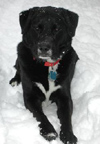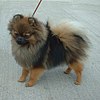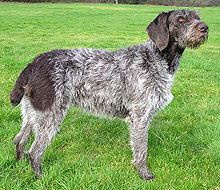Dog coat: Difference between revisions
m Script-assisted correction of misspellings |
Tag: possible conflict of interest |
||
| Line 167: | Line 167: | ||
* [http://www.dog.com/dog-clothes/see-all-dog-clothes/ Fun dog clothes] |
* [http://www.dog.com/dog-clothes/see-all-dog-clothes/ Fun dog clothes] |
||
* [http://www.greyhoundmegastore.com/page86.html Functional dog coats] |
* [http://www.greyhoundmegastore.com/page86.html Functional dog coats] |
||
* [http://www.fififashions.co.uk/Hoodies-by-K9_c_11.html Designer Dog Coats] |
|||
[[Category:Dog anatomy]] |
[[Category:Dog anatomy]] |
||
[[Category:Animal hair]] |
[[Category:Animal hair]] |
||
Revision as of 15:42, 5 July 2009
The coat of a dog is the pelage that covers its body.

A dog coat may be a double coat, made up of a soft undercoat and a coarse topcoat, or a single coat, without an undercoat. The terms fur and hair are often used interchangeably when describing dog coats, but in general, a double coat, such as that of the Newfoundland, is called a fur coat, while a single coat, such as the poodle's coat, may be called a hair coat.
Colours, patterns, textures
There is a greater variety of coat colours and patterns found in domestic (tame) dogs than in the wild wolf, even though dogs and wolves are of the same species. Coat colours in dogs were not likely initially selected for by humans but "were probably inadvertent outcomes of some other process...early selection for tameness.[1] Research has found that tameness brings associated inherited changes, especially in coat colours and patterns.[2][3]
Domestic dogs often display the remnants of counter-shading, a common natural camouflage pattern. The general theory of counter-shading is that when the animal is lit from above, it will appear lighter on its lower half and darker on its upper half, so that when observed from either above or below, it will blend in with the natural background. This type of natural camouflage is most apparent in birds and fish.[4][5]
Colour inheritance
A Stanford University School of Medicine study published in Science in October, 2007 found the genetics that explain coat colours in other mammals such as in horse coats and in cat coats, did not apply to dogs.[6] The project took samples from 38 different breeds to find the gene (a beta defensin gene) responsible for dog coat colour. One version produces yellow dogs, and a mutation produces black. All dog coat colours are modifications of black or yellow.[7] For example, the white in white miniature schnauzers is a cream colour, not albinism (a genotype of e/e at MC1R.)
Modern dog breeds exhibit a diverse array of fur coats, including dogs without fur, such as the Mexican Hairless Dog. Dog coats vary in texture, colour, and markings, and a specialized vocabulary has evolved to describe each characteristic.[8]
Colour names
 Brown Chesapeake Bay Retriever |
Brown and its variants, including mahogany, midtone brown, gray-brown, blackish brown; the Chesapeake Bay Retriever, whose colour "must be as nearly that of its working surroundings as possible", also uses the terms sedge and deadgrass. | |
 Red Irish Setter |
 Dark chocolate Australian Kelpie |
Red—reminiscent of reddish woods such as cherry or mahogany—and its variants, including chestnut, tawny, orange, roan, rust, red-gold, reddish brown, bronze, cinnamon, tan, ruby; also includes liver, a reddish brown somewhat the colour of cinnamon or bronze; the breed often determines whether "liver", "chocolate", "brown", or "red" is used to describe the colour, as in a liver German Shorthaired Pointer or a chocolate Labrador Retriever. |
| File:Toy poodle.jpg Apricot Poodle |
 Dark Golden Retriever |
Gold Rich reddish-yellow, as in a Golden Retriever, and its variants, including yellow-gold, lion-coloured, fawn, apricot, wheaten (pale yellow or fawn, like the colour of ripe wheat), tawny, straw, yellow-red, mustard, sandy, honey. |
 Yellow mixed-breed dog |
 Yellow Labrador Retriever |
Yellow—yellowish-gold tan, as in a yellow Labrador Retriever—and its variants, including blond and lemon. Lemon is a very pale yellow or wheaten colour which is not present at birth (the puppies are born white) but gradually becomes apparent, usually during the first six months of life. |
 Cream French Bulldog |
Cream: Sometimes it's hard to define the line between pale yellow and cream. Depending on the breed and individual, cream ranges from white through ivory and blond, often occurring with or beneath lemon, yellow, and sable. | |
 Black Newfoundland |
 Black Labrador Retriever |
Black: Usually pure black but sometimes grizzled, particularly as dogs age and develop white hairs, usually around the muzzle. |
| File:Kerry blue Terrier.jpg Kerry Blue Terriers |
 Blue merle Australian Shepherd |
Blue: Not the rainbow's blue but rather a dark metallic gray, often as a blue merle or speckled (with black). Kerry Blue Terriers, Australian Silky Terriers, Bearded Collies, and Australian Shepherds are among many breeds that come in blue. |
 Silver gray Weimaraner |
 Salt and pepper gray Miniature Schnauzer |
Gray—sometimes also called blue—and its variants, including pale to dark gray, silver, pepper, grizzle, slate, blue-black gray, black and silver, steel, lavender, silver-fawn. |
 White American Eskimo Dog |
 White Bichon Frisé |
White: Such a light cream that it is seen and described as pure white, making them distinct from albino dogs. A white dog, as opposed to an albino one, has dark pigment around the eye rims and nose, often coupled with dark-coloured eyes. There is often some coat identifiable as cream between the dog's shoulder blades. |
Patterns
Patterns, like colours, might be called by different terms for different breeds.
| File:AustrKelpieLiver2 wb.jpg Liver and tan Australian Kelpie |
 Black and Tan Coonhound |
Black and tan, liver and tan, blue and tan: Coat has both colours but in clearly defined and separated areas, usually with the darker colour on most of the body and tan (reddish variants) underneath and in highlights such as the eyebrows. Black and brindle and liver and brindle, in which the same pattern is evident with brindling in place of tan, are also possible, but less common. | |
 Black and white Border Collie |
 Blenheim (Red-brown and white) Cavalier King Charles Spaniel |
Bicolor (also called Two-color, Irish spotted, Flashy, Patched, Tuxedo) Any color or pattern coupled with white spotting. This can range anywhere from white toes and tail tip to a mostly-white dog with color around the base of the ears and tail. Some breeds have special names for the colour combinations; for example, Cavalier King Charles Spaniel uses Blenheim for reddish brown (chestnut) and white. Irish Spotted or flashy pattern is symmetrical and includes a white chest, white band around the neck, white belly, and white feet or "boots." This pattern is commonly seen in herding dogs, and Boxers, among others. | |
 Black tricolour Entlebucher Mountain Dog |
 Tricolour Beagle |
Tricolour: Three clearly defined colours, usually either black, liver, or blue on the dog's upper parts, white underneath, with a tan border between and tan highlights; for example, the Smooth Collie or the Sheltie. Tricolour can also refer to a dog whose coat is patched, usually two colours (such as black and tan) on a white background. | |
 Blue merle tricolour Australian Shepherd |
 Red merle Catahoula Leopard Dogs |
Merle: Marbled coat with darker patches and spots of the specified colour. Merle is referred to as "Dapple" with Dachshunds. | |
 Tuxedo mixed-breed dog |
 Tuxedo mixed-breed |
Tuxedo: Solid (usually black) with a white patch (shirt front) on the chest and chin, and white on some or all of the feet (spats.) Common colouration in Labrador mixes that may stem from the St. John's Water Dog ancestral breed. | |
 Harlequin Great Dane |
Harlequin: "ripped" sploches of black on white. Only the Great Dane exhibits this coat pattern. | ||
 Spotted Dalmatian |
Spotted Most often dark pigmented spots on a light background. The spotting on dalmatians is unique as it involves mutations in at least three different spotting genes | ||
 Red-speckled Australian Cattle Dog |
 Liver-ticked German Shorthaired Pointer |
Flecked, ticked, speckled: also called belton in English Setters | |
 Orange belton (orange and white speckled) English Setter |
 Blue speckled Australian Cattle Dog | ||
 Darker brindle and white Boston Terrier |
 Medium brindle Galgo Español |
Brindle: A mixture of black with brown, tan, or gold; usually in a "tiger stripe" pattern. | |
 Airedale Terrier with large black saddle |
Saddle or blanket: A different colour, usually darker, over the center of the back. | ||
 Dark orange sable Pomeranian |
 Lighter sable Shetland Sheepdogs |
Sable: Black-tipped hairs; the background colour can be gold to yellow, silver, gray, or tan. The darkness of the coat depends on how much of each hair is black versus the lighter colour. |
Texture
Texture, like colour and pattern, might be called by different terms for different breeds, even when referring to the same quality of coat. Some terms used to describe dog coat texture are smooth, rough, curly, straight, broken, and silky.
Coat textures vary tremendously. Densely furred breeds such as most sled dogs and Spitz types can have up to 600 hairs per inch, while fine-haired breeds such as the Yorkshire Terrier can have as few as 100, and the "hairless" breeds such as the Mexican Hairless and the Peruvian Inca Orchid have none on parts of their bodies. The texture of the coat often depends on the distribution and the length of the two parts of a dog's coat, its thick, warm undercoat (or down) and its rougher, somewhat weather-resistant outer coat (topcoat, also referred to as guard hairs). Breeds with soft coats often have more or longer undercoat hairs than guard hairs; rough-textured coats often have more or longer guard hairs. Textures include:

- Double-coated: Having a thick, warm, short undercoat (or down) that is usually dense enough to resist penetration by water and a stronger, rougher weather-resistant outer coat (topcoat), also referred to as guard hairs. Most other coat types are also double-coated.
- Single-coated: Lacking an undercoat.
- Smooth-coated: "Smooth" to the eye and touch.
- Wire-haired: Also called broken-coated. The harsh outer guard hairs are prominent, providing excellent weather protection for hunting dogs such as the Border Terrier or Wirehaired Pointing Griffon.
- Long-haired: Hair longer than an inch or so.
- Short-haired: Hair around an inch or so long.
- Corded coat: for example, see Puli
Show coats
The nature and quality of a purebred dog's coat is important to the dog fancy in the judging of the dog at conformation shows. The exact requirements are detailed in each breed's breed standard and do not generalise in any way, and the terminology may be very different even when referring to similar features. See individual breed articles for specific information.
Shedding
Every hair in the dog coat grows from a hair follicle, which has a cycle of growing, then dying and being replaced by another follicle. When the follicle dies, the hair is shed (moults). The length of time of the growing and shedding cycle varies by breed, age, and by whether the dog is an inside or outside dog.
Many dogs shed their undercoat each spring and regrow it again as colder weather comes in; this is also referred to as blowing the coat. Many domesticated breeds shed their coat twice a year. In some climates, the topcoat and undercoat might shed continuously in greater and smaller quantities all year.
Hypoallergenic coats
Some dog breeds have been promoted as hypoallergenic (which means less allergic, not free of allergens) because they shed very little or have the same pH as human hair. However, no canine is known to be completely nonallergenic. Often the problem is with the dog's saliva or dander, not the fur.[9] Although poodles and terriers (and mixes of poodles and terriers) are commonly represented as being hypoallergenic, the reaction that an individual person has to an individual dog may vary greatly. In treating dog related allergies, it has been found that "Factors related to individual dogs seem to influence the allergenicity more than breed..."[10]
Miscellaneous
Coat may also refer to a dog coat (also known as a dog rug); a garment made by humans to protect their pets from the elements.
Many short haired and elderly dogs may suffer from the cold and are kept warm and dry with a man made dog coat. The functional dog coat can be either a waterproof one to protect the dog's coat from getting wet or a warm dog coat to protect the dog from the cold. A man made coat for a dog can also be for decoration. Many dog accessory companies now sell dog coats and in recent years there has been an increase in designer dog clothing labels.
See also
- Dog grooming
- Cat coat genetics
- Equine coat color genetics
- Farm-Fox Experiment
- List of dog breeds
- Merle (coat colour in dogs)
- Hypoallergenic
References
- ^ The Domestic Dog By James Serpell, page 37, Cambridge University Press 1995, 2002, ISBN o521415292
- ^ Trut, Lyudmila N (1999), ""Early Canid Domestication: The Farm-Fox Experiment"" (PDF), American Scientist, 87 (2): 160–169. (A Russian study of pedomorphosis in a 40-year breeding program to domesticate red foxes.)
- ^ UNCOVERING THE GENETIC BASIS FOR TAMENESS – A RESEARCH STRATEGY F.W. Albert Department of Evolutionary Genetics, Max Planck Institute for Evolutionary Anthropology, Leipzig, Germany, 2008 (PDF file)
- ^ Klappenbach, Laura (2008). "What is Counter Shading?". About.com. Retrieved 2008-10-22.
- ^ Cunliffe, Juliette (2004). "Coat Types, Colours and Markings". The Encyclopedia of Dog Breeds. Paragon Publishing. pp. 20–3. ISBN 0752582763.
- ^ Candille SI, Kaelin CB, Cattanach BM; et al. (2007). "A -defensin mutation causes black coat colour in domestic dogs". Science. 318 (5855): 1418–23. doi:10.1126/science.1147880. PMID 17947548.
{{cite journal}}: Explicit use of et al. in:|author=(help); Unknown parameter|month=ignored (help)CS1 maint: multiple names: authors list (link) - ^ Stanford University Medical Center, Greg Barsh et al. (2007, October 31). Genetics Of Coat Color In Dogs May Help Explain Human Stress And Weight. ScienceDaily. Retrieved September 29, 2008
- ^ "Genetics of Coat Color and Type in Dogs". Sheila M. Schmutz, Ph.D., Professor, University of Saskatchewan. October 25, 2008. Retrieved 11/05 2008.
{{cite web}}: Check date values in:|accessdate=(help); Unknown parameter|dateformat=ignored (help) - ^ "Nonallergenic Dog? Not Really" by Denise Grady, New York Times, 5 Feb 1997
- ^ Heutelbeck ARR, Schulz T, Bergmann K, Hallier E (2008). "Environmental Exposure to Allergens of Different Dog Breeds and Relevance in Allergological Diagnostics". Journal of Toxicology and Environmental Health, Part A. 71 (11–12): 751–8. doi:10.1080/15287390801985513.
{{cite journal}}: Unknown parameter|month=ignored (help)CS1 maint: multiple names: authors list (link)
- Cunliffe, Juliette (2004). "Coat Types, Colours and Markings". The Encyclopedia of Dog Breeds. Paragon Publishing. pp. 20–23 and various.
- Fogle, Bruce (2000). "The Breed Section Explained". The New Encyclopedia of the Dog. Dorling Kindersley. p. 83 and various. ISBN 0751304719.
